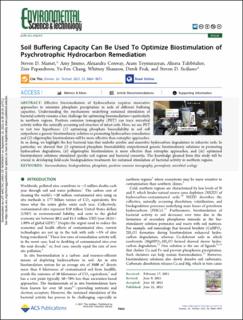Soil Buffering Capacity Can Be Used To Optimize Biostimulation of Psychrotrophic Hydrocarbon Remediation
| dc.contributor.author | Mamet, Steven D. | |
| dc.contributor.author | Jimmo, Amy | |
| dc.contributor.author | Conway, Alexandra J. | |
| dc.contributor.author | Teymurazyan, Aram | |
| dc.contributor.author | Talebitaher, Alireza | |
| dc.contributor.author | Papandreou, Zisis | |
| dc.contributor.author | Chang, Yu-Fen | |
| dc.contributor.author | Shannon, Whitney | |
| dc.contributor.author | Peak, Derek | |
| dc.contributor.author | Siciliano, Steven D. | |
| dc.coverage.spatial | Yukon, Old Crow | en_US |
| dc.date.accessioned | 2021-09-20T11:19:45Z | |
| dc.date.available | 2021-09-20T11:19:45Z | |
| dc.date.created | 2021-06-26T01:28:15Z | |
| dc.date.issued | 2021 | |
| dc.identifier.citation | Mamet, S. D., Jimmo, A., Conway, A., Teymurazyan, A., Talebitaher, A., Papandreou, Z., Chang, Y.-F., Shannon, W., Peak, D., & Siciliano, S. D. (2021). Soil buffering capacity can be used to optimize biostimulation of psychrotrophic hydrocarbon remediation. Environmental Science & Technology, 55(14), 9864-9875. | en_US |
| dc.identifier.issn | 0013-936X | |
| dc.identifier.uri | https://hdl.handle.net/11250/2779180 | |
| dc.description.abstract | Effective bioremediation of hydrocarbons requires innovative approaches to minimize phosphate precipitation in soils of different buffering capacities. Understanding the mechanisms underlying sustained stimulation of bacterial activity remains a key challenge for optimizing bioremediation—particularly in northern regions. Positron emission tomography (PET) can trace microbial activity within the naturally occurring soil structure of intact soils. Here, we use PET to test two hypotheses: (1) optimizing phosphate bioavailability in soil will outperform a generic biostimulatory solution in promoting hydrocarbon remediation and (2) oligotrophic biostimulation will be more effective than eutrophic approaches. In so doing, we highlight the key bacterial taxa that underlie aerobic and anaerobic hydrocarbon degradation in subarctic soils. In particular, we showed that (i) optimized phosphate bioavailability outperformed generic biostimulatory solutions in promoting hydrocarbon degradation, (ii) oligotrophic biostimulation is more effective than eutrophic approaches, and (iii) optimized biostimulatory solutions stimulated specific soil regions and bacterial consortia. The knowledge gleaned from this study will be crucial in developing field-scale biodegradation treatments for sustained stimulation of bacterial activity in northern regions. | en_US |
| dc.language.iso | eng | en_US |
| dc.publisher | ACS Publications | en_US |
| dc.rights | Attribution-NonCommercial-NoDerivatives 4.0 Internasjonal | * |
| dc.rights.uri | http://creativecommons.org/licenses/by-nc-nd/4.0/deed.no | * |
| dc.subject | bioremediation | en_US |
| dc.subject | biodegradation | en_US |
| dc.subject | phosphate | en_US |
| dc.subject | positron emission tomography | en_US |
| dc.subject | permafrost | en_US |
| dc.subject | microbial ecology | en_US |
| dc.title | Soil Buffering Capacity Can Be Used To Optimize Biostimulation of Psychrotrophic Hydrocarbon Remediation | en_US |
| dc.type | Peer reviewed | en_US |
| dc.type | Journal article | en_US |
| dc.description.version | publishedVersion | en_US |
| dc.rights.holder | © 2021 The Authors | en_US |
| dc.source.pagenumber | 9864-9875 | en_US |
| dc.source.volume | 55 | en_US |
| dc.source.journal | Environmental Science and Technology | en_US |
| dc.source.issue | 14 | en_US |
| dc.identifier.doi | 10.1021/acs.est.1c01113 | |
| dc.identifier.cristin | 1918668 | |
| cristin.ispublished | true | |
| cristin.fulltext | original | |
| cristin.qualitycode | 2 |
Tilhørende fil(er)
Denne innførselen finnes i følgende samling(er)
-
Import fra CRIStin [3604]
-
Institutt for maskin- og marinfag [365]

